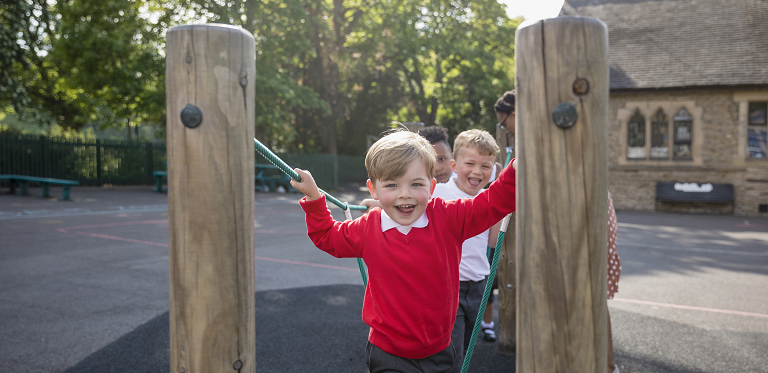High quality outdoor learning and experiences

Quick links:
Information about the school
Sandycroft Primary School is in Mancot, in Flintshire local authority. There are 354 pupils on roll. The school has 14 single aged classes, including three nursery classes. Around 24% of pupils are eligible for free school meals. The school identifies around 32% of pupils as having additional learning needs. Around 14% of pupils speak English as an additional language and a very few pupils speak Welsh at home. Currently, around 5% of pupils are members of the gypsy traveller community.
Context and background to the effective or innovative practice
Sandycroft Primary School has large grounds, made up of a traditional playing field and an area of what was wasteland, which had not been used by the school for many years.
The school systematically developed the grounds over many years using a variety of different strategies and approaches. The bulk of this work was driven by staff, parents and governors in their own time after school and in holidays. This kept costs to a minimum. The school was also able to gain funding from local businesses and grants with various organisations. Using the grant funding, it was able to purchase large play equipment such as a castle, pirate ship, play pods and a climbing wall. Local businesses were also involved practically, and they provided their staff to work on projects, such as planting an arboretum and installing sports equipment such as a basketball area.
However, the main drive behind the work was the school using parents’, staff’s and governors’ own DIY skills to develop a range of outdoor classrooms, an outdoor scrapyard and outdoor provision areas to support learning and well-being across all age ranges. The school has also invested in ample storage to ensure that resources are rotated on a regular basis to maintain pupil interest.
In addition to this, the playground has been organised into a range of play, sport, craft and practical areas to accommodate the broad interests of the pupils. Pupil voice is a key aspect of this planning. This enables them to be actively engaged at break times with a range of activities and sports.
Description of nature of strategy or activity
The school aims to provide high quality outdoor learning and experiences that encompass one or more of the following elements:
- generally takes place outdoors
- often has an adventurous component
- involves physical activity
- respects the natural environment at all times
- develops curiosity and innovation
- promotes cooperation and teamwork
- encourages resilience and determination
- develops gross and fine motor skills
There is a whole-school focus on outdoor learning. Equal weighting is given to outdoor learning that occurs in lessons and during play times. All staff are involved and understand that the outdoors can be used to develop understanding in each area of learning and experience. There is a large breadth and range of activities and resources that the pupils can access. As a result, the outdoors is very flexible to meet the needs of the curriculum. The school provides a range of outdoor clothing for staff and pupils including waterproofs, wellies and PPE where appropriate to ensure that the weather does not restrict opportunities for outdoor learning.
What impact has this work had on provision and learners’ standards?
- A whole school focus on outdoor learning encourages and enthuses pupils to attend regularly and is used exceptionally well to enhance pupils’ physical and mental health.
- The pupils thrive in the extensive and well-developed outdoor areas, no matter what the weather.
- The stimulating outdoors ensure that the levels of engagement are good.
- The range of activities ensures that outdoor learning is used across the curriculum. For example, the youngest pupils develop their knowledge of number in the outdoor environment. They collect and count natural objects in the school grounds and use the objects to make repeating patterns. By Year 2, pupils confidently measure planks of wood in standard units and problem-solve how to fill a gap with a suitable length of wood, when building a bridge.
- Older pupils show resilience when problem-solving, both in the classroom and at break times, often through interesting and authentic experiences in the workshop. They persevere with tasks and attempt alternative ways of working.
- Nearly all pupils investigate their surroundings and develop their imaginations. For instance, the youngest pupils plant seeds to develop their school garden areas, use diggers to build sandcastles when creating imaginary towns and sing and dance on the outdoor stage.
- Older pupils develop many useful life skills, for example when caring for the school’s free-range chickens, and when working as teams to problem-solve in the forest school.
- Pupils enjoy using their creative and artistic skills. For example, they create three dimensional observational pictures using natural materials and fruit that they collect from the school’s orchard.
- The development of pupils’ physical skills is excellent.
- Most pupils develop balance, co-ordination and strength very well when using the extensive outdoor provision, such as the climbing wall, castle structure and forest school.
- Pupils develop their gross and fine motor skills in the outdoor ‘scrapyard’, which is particularly impressive. They use a wide range of tools, such as socket sets, spanners and screwdrivers, safely to dismantle household objects and machinery. This also helps them to begin to explore the mechanics of how these items work.
The outdoors is an essential part of every pupil’s daily life in school. The impact on them is not isolated to any one area; it develops them holisticially.
How have you shared your good practice?
The school gets regular visits from other schools and has hosted a working group for the consortium focused on health and well-being.